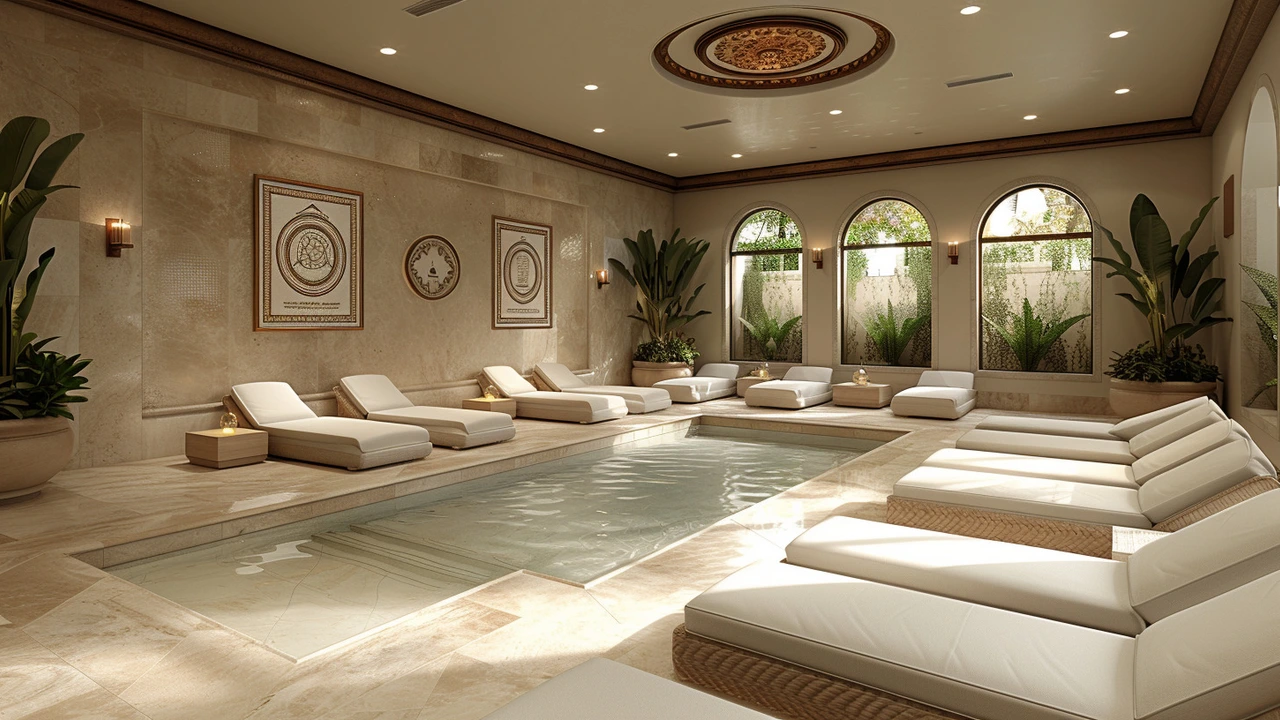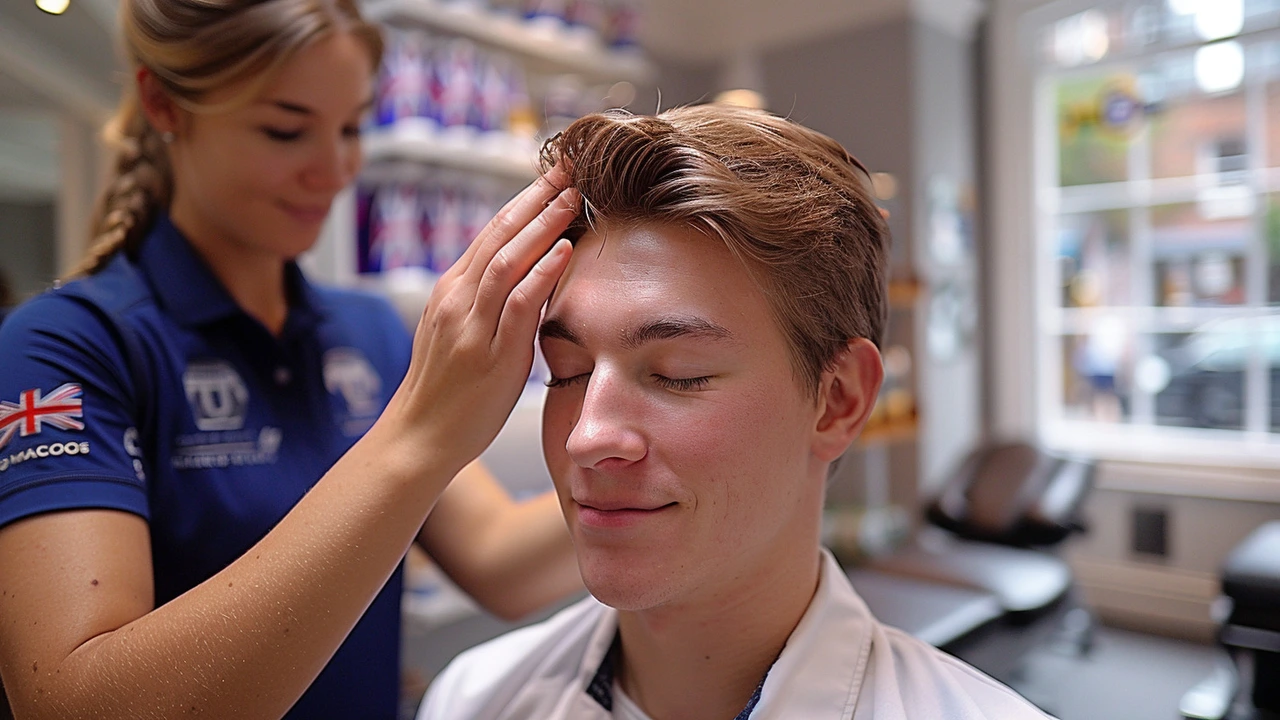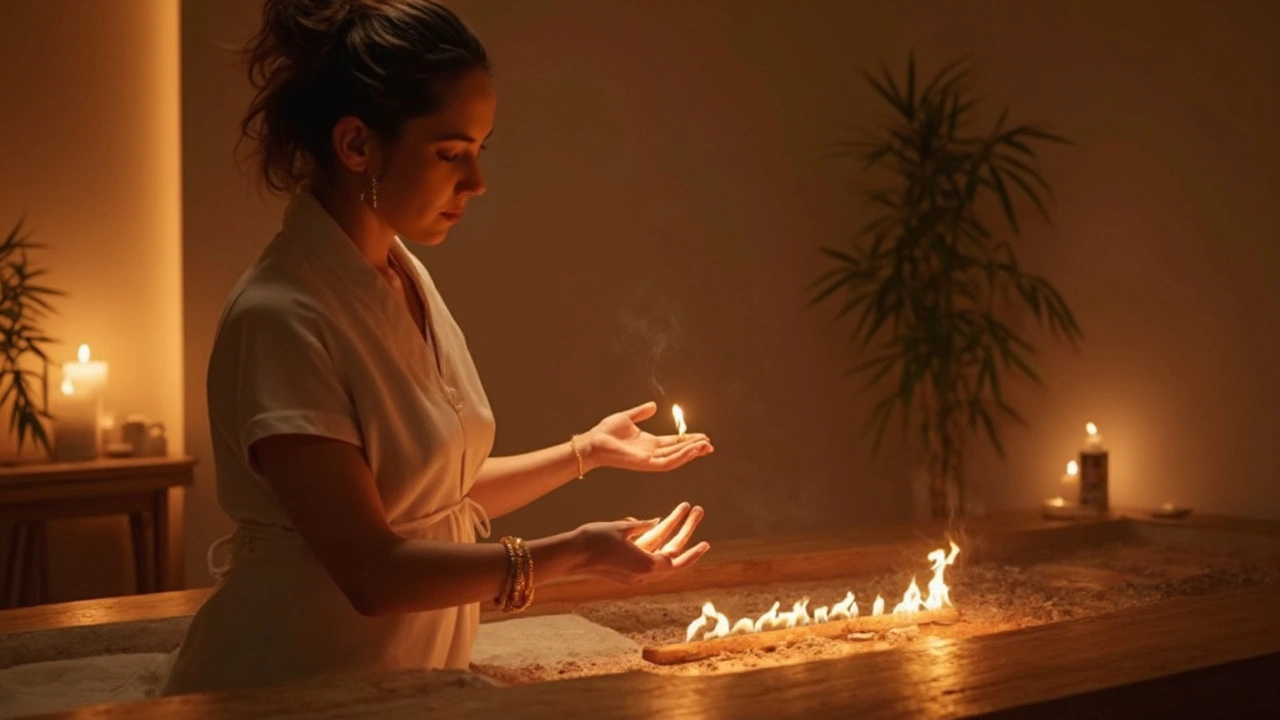Chair Massage: The Ultimate Stress-Busting Tool for Instant Relief
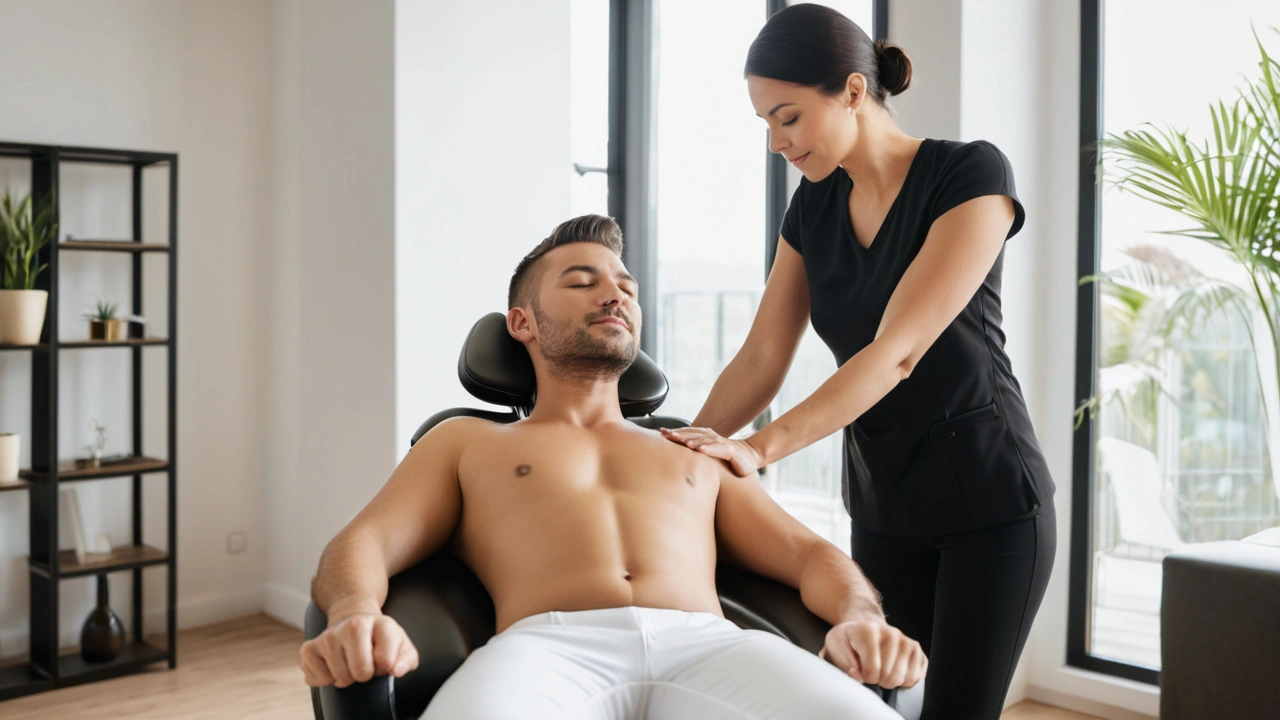
In today's fast-paced world, stress often feels like a constant companion. Many of us are looking for simple yet effective ways to relax and recharge. Chair massage has emerged as a popular solution, offering a quick and easy method to reduce stress and tension.
A chair massage focuses on key areas like the head, neck, shoulders, and back. Unlike traditional massages, you don't need to undress or lie down, making it perfect for busy schedules. The best part? It can be done almost anywhere—from offices to airports.
- Understanding Chair Massage
- Benefits of Chair Massage
- Techniques Used in Chair Massage
- Where to Get a Chair Massage
- Tips for an Effective Chair Massage
Understanding Chair Massage
Chair massage, often called seated massage, is designed to provide relaxation and stress relief without the need for a dedicated massage table. It's done while the person is sitting fully clothed in a specially designed chair that supports the arms, head, and chest, allowing the massage therapist to access key muscle groups effectively.
The roots of chair massage can be traced back to ancient Chinese massage techniques that emphasized the importance of acupressure points along meridian lines. Modern chair massage was popularized in the 1980s by David Palmer, who saw the potential for providing quick yet impactful stress relief in corporate settings. Today, it's not uncommon to see chair massage services in offices, airports, malls, and even outdoor festivals, making it a versatile option for many.
“Chair massage is designed for busy people who need quick relief from the daily grind. It's effective and convenient, making it accessible for anyone, anywhere,” explains David Palmer, the pioneer of modern chair massage.
One of the significant advantages of chair massage is the immediacy of its benefits. A typical session lasts between 15 to 30 minutes, focusing on the back, shoulders, neck, and arms, which are common areas for tension build-up. Because the massage targets these specific areas, it often provides relief much faster than a full-body massage might.
Chair massage can be a viable option for those who may feel uncomfortable with the idea of traditional massage, which requires undressing and lying down. The ergonomic design of the chair ensures comfort and support, allowing the therapist to apply the right amount of pressure without causing discomfort. The portability of the chair means that therapists can bring their services to a variety of locations, making it a go-to choice for businesses looking to improve employee wellness.
Techniques Employed in Chair Massages
Chair massages use a combination of techniques such as kneading, compression, and percussion to alleviate muscle tension and improve circulation. The therapist often starts with light kneading to warm up the muscles before moving on to deeper compressions. Percussion techniques, such as tapping or drumming, might also be used to relieve tightness and stimulate muscle relaxation.
Acupressure is another common technique used in chair massages. By applying pressure to specific points on the body, the therapist can help to release energy blockages and promote overall balance. This method is rooted in traditional Chinese medicine and is particularly effective for relieving stress and boosting energy levels.
Understanding the mechanics of chair massage helps in recognizing its benefits and suitability for different needs. The convenience, combined with its targeted approach, makes chair massage a practical option for anyone looking to incorporate relaxation and stress relief into their daily routine.
Benefits of Chair Massage
Chair massages offer a variety of benefits that can make a tangible difference in both your physical and mental well-being. One of the most immediate benefits is stress relief. With just 15 minutes of a chair massage, the body can start to relax, tension can ease away, and you might find your mood lifting. It's amazing what such a short burst of relaxation can do when you're feeling overwhelmed or anxious.
If you're concerned about muscle aches from sitting or working in front of a computer all day, you’ll be glad to know that chair massages can significantly help. They target areas that often harbor tension like the upper back, shoulders, and neck. By concentrating on these zones, a chair massage can improve circulation and reduce muscle pain. This can also lead to better posture and fewer tension headaches, which are common issues among professionals who sit at desks for long hours.
Another fantastic benefit is the boost to the immune system. Regular massages have been shown to increase the activity of white blood cells, helping the body fend off illnesses. A study by the University of Miami School of Medicine found that chair massages could help increase the production of white blood cells, thus contributing to a stronger immune response. Less stress on your plate means your body can focus more energy on staying healthy.
"Research has shown that massage therapy can reduce the production of cortisol, the stress hormone, by up to 30 percent," says Dr. Tiffany Field, Director of the Touch Research Institute at the University of Miami School of Medicine. "This reduction in stress can lead to improved immune system function, better sleep, and overall enhanced mood."
Improved mental clarity is another plus. The act of taking a break and allowing yourself to relax can give your mind a chance to rest. This brief pause can help you return to work or daily activities with fresh energy and sharper focus. In fact, some companies are investing in chair massage programs for their employees to enhance productivity and workplace satisfaction.
Mental health benefits don't end there. Regular chair massages can also reduce symptoms of depression and anxiety. By lowering cortisol levels and boosting the production of serotonin and dopamine (feel-good hormones), these quick sessions can make a big improvement in one's overall sense of well-being.
Enhanced Circulation and Pain Relief
Chair massages can help enhance blood flow throughout the body. This increased circulation can aid in faster recovery from minor injuries and decreased muscle soreness. When muscles are relaxed, blood can flow more freely, bringing with it the oxygen and nutrients needed for repair and vitality.
For those dealing with chronic pain conditions, like arthritis or fibromyalgia, chair massages can provide significant relief. By focusing on pressure points and gently working through tension, even a short session can make a noticeable difference in pain levels. It's a non-invasive and natural approach to managing long-term pain without the need for medication.
Taking regular chair massages can also elevate your mood. The rhythmic pressure and movement help to release endorphins, the body's natural painkillers and mood enhancers. After a session, many people report feeling more balanced and at ease, shedding the weight of their stress and tension.
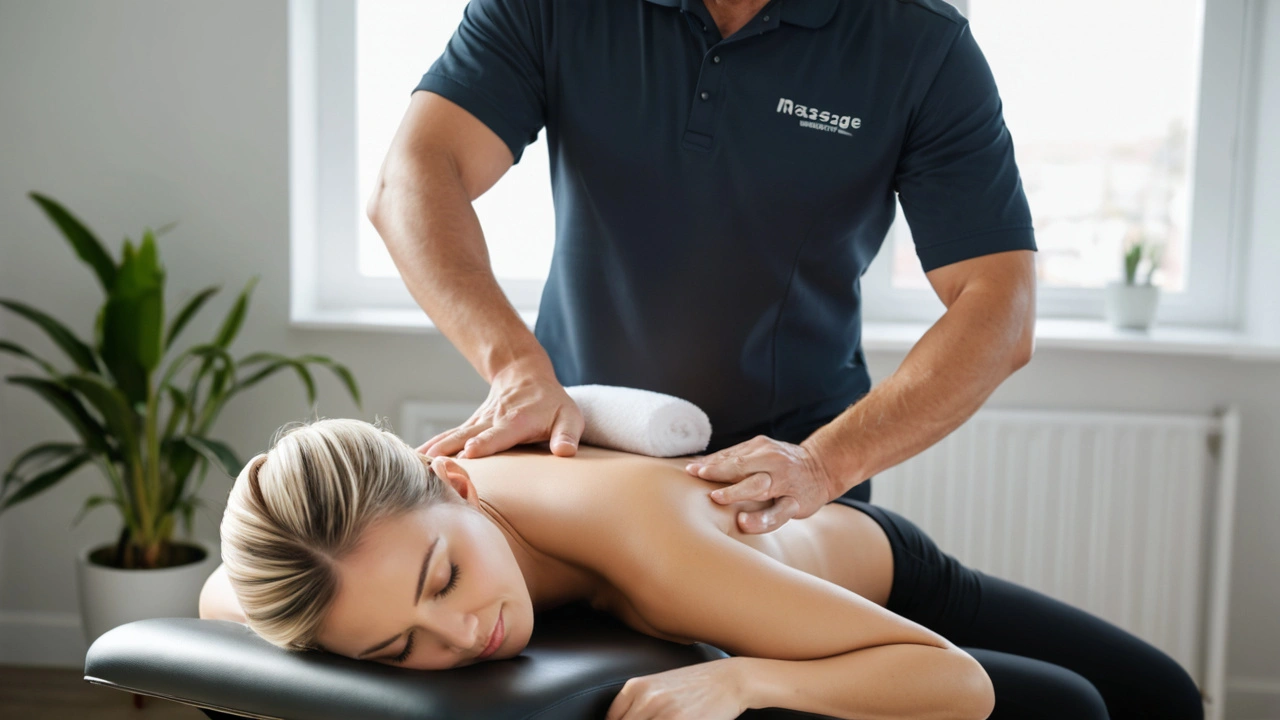
Techniques Used in Chair Massage
Chair massage employs several techniques aimed at providing rapid relief from tension and stress. One common technique is compression, which involves rhythmic pressing or rolling movements over muscles and tissues. This helps to improve blood flow and reduces muscle stiffness.
Another widely used technique is kneading. Kneading mimics the motion of kneading dough, targeting muscles to release knots and reduce muscle tightness. It works wonders on the neck, shoulders, and back, areas where we often carry stress.
Tapotement, also known as percussion, includes a series of rapid percussive movements like tapping or chopping. This technique stimulates circulation and helps energize the body. It's often used towards the end of the massage to leave you feeling invigorated.
For those suffering from tech neck or other posture-related issues, a technique called petrissage can be very effective. Petrissage involves lifting and squeezing muscles, which aids in the release of deep-seated tension. It's particularly good for breaking down adhesions in muscle fibers.
Then there's friction, which entails rubbing motions performed with the fingers or palms. It generates heat, which promotes blood flow and assists in breaking up scar tissue or adhesions.
The incorporation of acupressure points is also common in chair massage. By targeting these points on your body, practitioners can relieve pain and tension. These points are based on Traditional Chinese Medicine and are thought to clear energy blockages in the body.
"Chair massage is an efficient way to provide deep relaxation and immediate stress relief," says Dr. Jane Smith, a renowned stress management expert. "Through various techniques, it addresses both physical and emotional stress."
Understanding these techniques can help you better appreciate the benefits of a chair massage. Knowing what to expect can also make the experience more enjoyable and effective. Always communicate with your massage therapist about your needs and any discomfort you may feel, as massage should be a comforting and uplifting experience.
Where to Get a Chair Massage
Finding a place to enjoy a chair massage isn't as difficult as you might think. One of the most accessible locations is at your workplace. Many companies now recognize the benefits of employee wellness programs and often have partnerships with massage therapists who visit the office. This setup allows you to get a quick and effective massage during your break, rejuvenating your mind and body for the rest of the workday.
Another common place to find chair massages is at airports. Amidst the hustle of air travel, a chair massage station can be a haven of relaxation. These services are typically available near departure gates and waiting areas, offering travelers a chance to unwind before or after a flight. A quick 15-minute session can make a world of difference in reducing travel-related stress and fatigue.
Shopping malls are also jumping on the relaxation bandwagon. Many malls now feature kiosks dedicated to chair massages. It’s a convenient way to take a break from a long day of shopping or to treat yourself after running errands. These kiosks are usually staffed by certified massage therapists who know just how to tackle the knots and tension built up from daily activities.
Events and conventions are other prime spots for chair massages. Conference organizers increasingly include wellness activities in their agendas to boost attendee satisfaction. A brief massage can be a perfect refresher between sessions, helping participants stay focused and energetic. Corporate events, health expos, and even festivals often feature chair massage options.
You'd be surprised to find chair massages even in some retail stores and cafes! These establishments are keen to enhance customer experience and loyalty by offering unique add-ons. Imagine sipping your favorite coffee while getting a soothing massage. It's a win-win for both business and relaxation.
If you're seeking a more personalized experience, don't forget the option of hiring a mobile massage therapist. These professionals come to your home, bringing all necessary equipment, including a comfortable massage chair. It’s perfect for those who prefer a private setting or have specific scheduling needs. Mobile therapists can often tailor the session length and style according to your preferences.
Chair massage truly stands out for its versatility and convenience. With so many venues offering this service, you're never far from an opportunity to ease stress and boost your well-being. According to the American Massage Therapy Association, “Stress relief is the primary reason people get massages.”
“Incorporating regular chair massages can profoundly impact one's overall health,” says Dr. James R. Jacobs, a noted expert in the field.Wherever you decide to enjoy a chair massage, you're sure to appreciate the benefits of this quick and effective stress-busting tool.
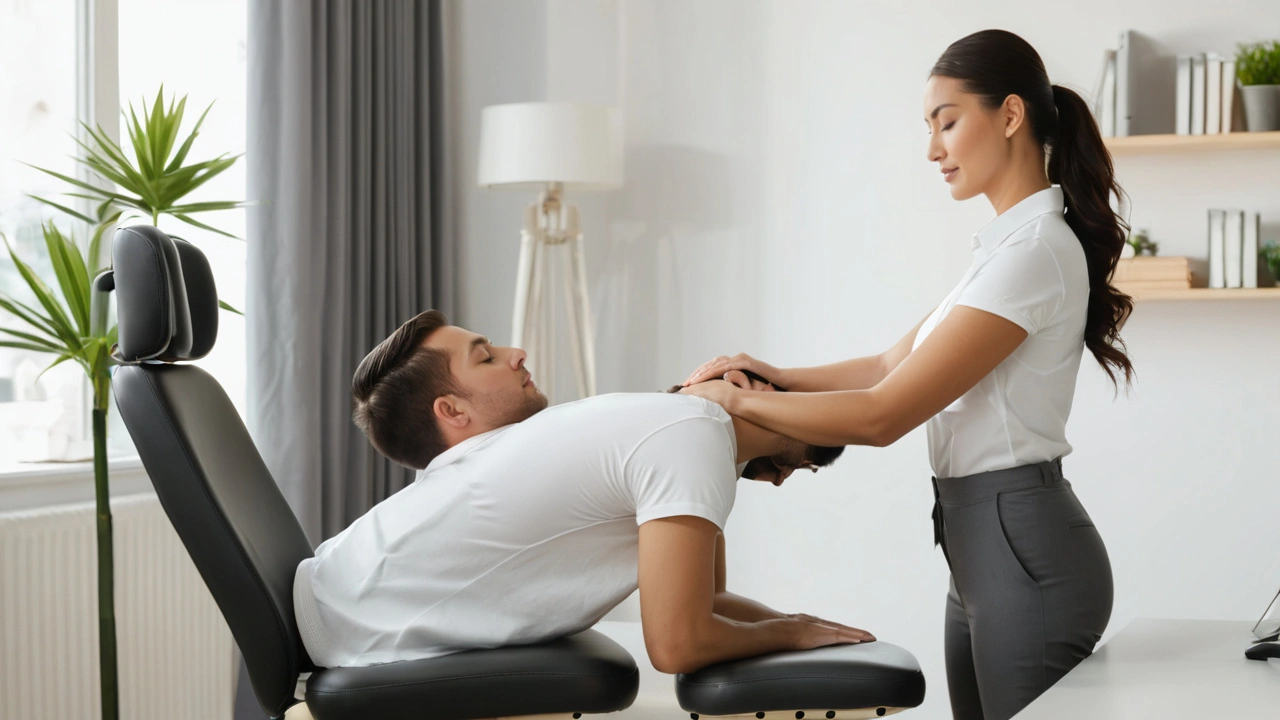
Tips for an Effective Chair Massage
Chair massages can be a fantastic way to relieve stress and tension, but to get the most out of them, it's important to keep a few tips in mind. First, always choose a comfortable and supportive chair. This makes it easier for the massage therapist to reach key areas and ensures you can fully relax. Look for a stable chair with a firm backrest and comfortable padding.
Make sure you're dressed in comfortable clothing that allows easy access to your neck, shoulders, and back. This helps the therapist focus on those tight spots without the need for you to undress. If possible, opt for loose-fitting clothes that are easy to move in and don't restrict blood flow.
Hydration is key. Drinking water before and after your chair massage helps flush out the toxins released during the session. It also helps keep your muscles and tissues hydrated, making the massage more effective. It's a small step, but it can make a big difference in how you feel afterward.
Dr. Mary Perkinson, a well-known chiropractor, explains, "Staying hydrated is essential, as it enhances the benefits of the massage and aids in the body's natural detoxifying process."
Before starting, inform your therapist about any specific aches, pains, or areas of tension. Clear communication ensures that the massage targets the areas where you need it most. Whether it's a stiff neck from too much screen time or lower back pain from sitting too long, your therapist can adjust techniques to address your needs.
Breathing deeply during the massage session can help you relax more fully and enhance the experience. Slow, steady breaths can reduce stress levels and improve circulation. Sometimes, people hold their breath in anticipation of pain or discomfort, but focusing on your breath can help you stay calm and relaxed.
Positioning and Timing
Proper positioning is crucial for an effective chair massage. Sit upright with your feet flat on the ground and your arms resting comfortably. Adjust the chair height if needed to ensure your hips and knees are at right angles, which promotes good posture. Keep your head and neck relaxed to help the therapist reach those areas more easily.
A 10-20 minute chair massage can be incredibly effective, but don't feel pressured to rush. Allow yourself enough time to unwind and enjoy the benefits. If you're scheduling a massage at work, try to carve out a small window where you won't be interrupted or need to multitask.
A fascinating fact is that regular chair massages have been shown to reduce cortisol levels, the hormone responsible for stress, by up to 31%. Adding them to your routine can have long-term benefits for both your mental and physical wellbeing.
Post-Massage Care
After the massage, take a few moments to stand up slowly and stretch gently. This helps your body adjust and makes the most of the relaxed state achieved during the session. If possible, avoid jumping straight back into a hectic schedule. Allow time for your body to reap the benefits of the massage, and if you're at work, take a short walk or do some light stretching.
Consider integrating chair massages into your regular wellness routine. Whether weekly, bi-weekly, or monthly, consistency can magnify the benefits. Look out for local practitioners who offer chair massages at reasonable rates, or explore options in community centers and wellness programs.


